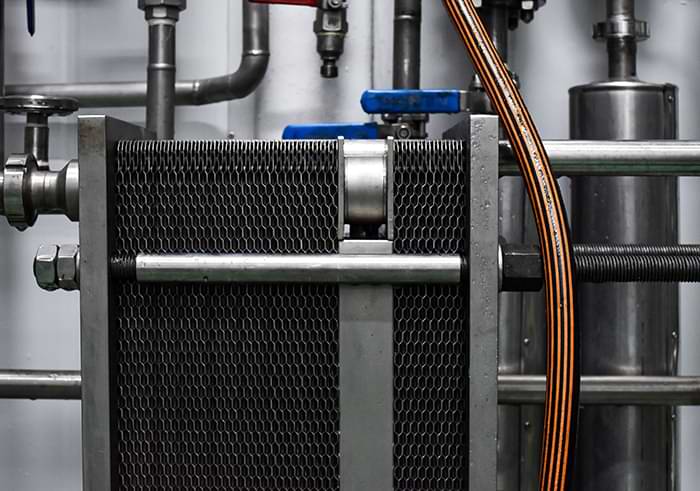Gasketed Plate & Frame
The sanitary Accu-Therm plate heat exchanger surpasses the most stringent sanitary requirements for human consumption, and is designed to meet a wide variety of sanitary process applications.
- Certified: 3A certified to meet stringent sanitary standards and regulations.
- Easy to Use: Features clean-in-place (CIP) capability for efficient, automated cleaning without disassembly.
- No Clog Design: Our innovative "Free-Flow" plates allow easy flow of viscous liquids and fluids with particulate up to 3/8" that can clog conventional plate heat exchangers.
- Plate Sizes: We offer the most extensive plate selection on the market today.
- Timely Delivery: In-house manufacturing and a large inventory of components allow for quick assembly and shipment.
- Safety: CIP minimizes errors through automating the cleaning process to reduce the probability of human error that can result in an unsafe product.

Sanitary Plate Heat Exchanger
High Quality Heat Transfer Solutions
Accu-Therm® plate heat exchangers ensure hassle-free, exceptionally efficient heat transfer for handling various fluids, from straightforward solutions to thick mixtures and solids. With a wide array of sizes, materials, and frame options, our plate heat exchangers are tailored precisely to fulfill your specific requirements.
- Compact and Lightweight
- Close Approach Temperatures
- Capable of High Flow Rates
- Expandable
- Reduced Fouling
- Multiple Duties in a Single Unit
Sanitary Plate & Frame Exchangers
With their high level of efficiency in heat transfer, these heat exchangers play a pivotal role in critical processes including pasteurization, sterilization, cooling, and heating operations. The construction of sanitary plate and frame heat exchangers enables them to handle a range of temperatures and pressures, making them suitable for various applications.
The design allows for ease in assembly and disassembly, which is crucial for the frequent cleaning and inspection mandated by the hygiene protocols in a number of industries. The compact footprint of plate and frame heat exchangers offers an advantage in facilities where space conservation is essential. Additionally, the modular nature of these systems permits scalability to accommodate varying process demands.
Furthermore, the customizable configuration of plates allows for optimization according to specific process requirements, ensuring that the equipment can provide effective heat transfer while maintaining the quality and integrity of sensitive products that require precise temperature control. Plate and frame units also allow for temperature crosses to occur within a single unit, unlike shell and tube designs.
Advanced Approach Temperatures
Accu-Therm® plate heat exchangers achieve remarkable approach temperatures of 2 to 3°F, thanks to their true counterflow design and exceptional heat transfer efficiency. This capability ensures precise temperature control and energy savings across various fluid processing needs.
Compact and Lightweight Design
Compared to traditional heat transfer equipment, Accu-Therm® plate exchangers require significantly less floor space—only 1/5 to 1/2 of the area—due to their compact build. Additionally, they are lighter in weight, achieved through reduced liquid volume and a more efficient surface area tailored to specific applications.
Versatile Connections
Featuring studded ports as standard, which can be fully lined for added protection against erosion and corrosion, Accu-Therm® units also offer a variety of connection options including lap-joint, weld-neck, ferrule, and victaulic. This flexibility allows for custom configurations that suit individual operational needs.
Cross Contamination Prevention
Each medium within the exchanger is securely gasketed, with vented spaces between gaskets to prevent cross contamination. This design ensures the integrity and purity of each fluid stream, meeting stringent industry standards.
Easy Inspection and Maintenance
Inspecting and cleaning Accu-Therm® heat exchangers is straightforward. By simply removing compression bolts and sliding away the movable end frame, operators can access and inspect the entire heat transfer surface. Cleaning-in-place (CIP) processes are also efficient and cost-effective, minimizing downtime.
Expandable Performance
Accu-Therm® units are designed for scalability. Operators can adjust thermal performance by adding or removing plates, ensuring operational flexibility and efficiency as demands change.
Diverse Selection
With heat transfer surface areas ranging from 0.5 to 51 square feet and multiple embossed patterns available, Accu-Therm® plate heat exchangers offer a wide selection to meet specific application requirements. The exclusive "free-flow" plate design enhances performance across diverse industrial settings.
Robust Construction and Performance
Built with heavy-duty frames and optimized plate pack compression, Accu-Therm® units ensure leak prevention and long-term reliability. They achieve high turbulence at low fluid velocities, resulting in exceptional heat transfer coefficients and "U" values of up to 1,500.
High Flow Rates and Efficiency
Accu-Therm® plate exchangers support flows up to 24,000 gpm and port diameters up to 20 inches, delivering high efficiency and throughput. Rigorous quality assurance testing ensures each circuit operates at full design pressure, with ASME registration available for added assurance.
Cost-Effective Solution
Compared to other heat exchanger types, Accu-Therm® units offer superior thermal efficiency and lower manufacturing costs, making them a more economical choice for industrial applications.
Versatile Applications
Accu-Therm® plate exchangers can handle multiple duties within a single unit, efficiently heating or cooling two or more fluids simultaneously. They accommodate up to 25,000 square feet of heat transfer surface in a single exchanger, supporting diverse operational needs with minimal maintenance.
Enhanced Fouling Resistance and Safety
Designed with high turbulence, uniform fluid distribution, smooth plate surfaces, and optional OSHA-approved shrouds, Accu-Therm® plate heat exchangers minimize fouling and ensure personnel safety, enhancing operational efficiency and longevity. In conclusion, Accu-Therm® plate heat exchangers combine advanced technology with practical design to deliver unmatched performance, efficiency, and reliability across a spectrum of industrial applications. Whether optimizing space, enhancing thermal efficiency, or ensuring operational safety, these units stand as a cornerstone of modern heat transfer solutions.


